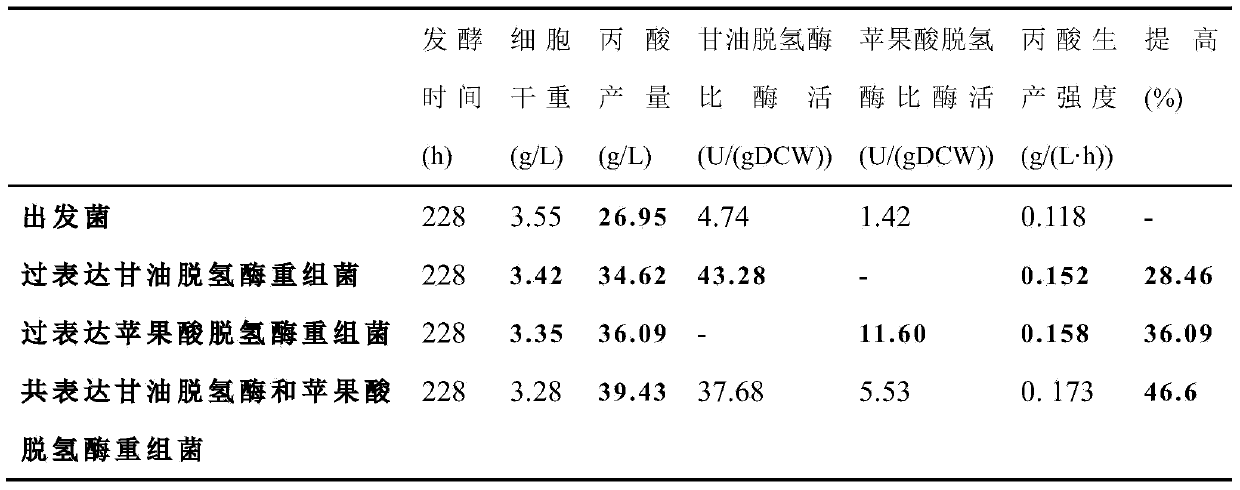High-yield propionic acid propionibacterium jensenii engineering bacterium and application thereof
A technology of Propionibacterium jannaschii and engineering bacteria, applied in the field of genetic engineering, can solve the problems of low utilization rate of glycerol, low product efficiency and high cost of propionic acid, and achieve the effect of improving the production capacity of propionic acid fermentation
- Summary
- Abstract
- Description
- Claims
- Application Information
AI Technical Summary
Problems solved by technology
Method used
Image
Examples
Embodiment 1
[0030] Embodiment 1 The construction of the acquisition of Klebsiella pneumoniae gldA gene and mdh gene and expression plasmid
[0031] The gldA gene and the mdh gene can be obtained by chemical total synthesis, and can also be obtained by the following PCR method.
[0032] (1) Using the whole genome sequence of Klebsiella pneumonia subsp.pneumoniae ATCC 12657 as a template, the target fragments of gldA gene and mdh gene with the expected size were obtained by PCR amplification.
[0033] (2) When two genes are co-expressed: the target gene is connected to the expression vector pZGX04 through blunt ends to obtain the recombinant expression plasmid pZGX04-gldA-mdh. After sequencing verification, the connection was proved to be correct.
[0034] (3) When only the malate dehydrogenase gene is overexpressed: the target gene is connected to the expression vector pZGX04 through blunt ends to obtain the recombinant expression plasmid pZGX04-mdh. After sequencing verification, the co...
Embodiment 2
[0037] Example 2 Construction and Identification of Recombinant Bacteria
[0038] Due to the restrictive modification in Propionibacterium jensenii, after the recombinant plasmid was amplified by E. coli JM109, it was first transformed into E. coli JM110, and the recombinant plasmid extracted from E. coli JM110 was electrotransformed into P. jensenii CCTCC No. :M 2013071, which was spread to seed medium containing chloramphenicol resistance. Immediately, the transformant was selected for colony PCR verification, and a positive transformant was obtained, and the plasmid was further isolated for sequencing verification to confirm that the recombinant Propionibacterium janesii was obtained.
Embodiment 3
[0039] Embodiment 3 Recombinant bacteria and control bacteria fermentation experiment
[0040] Separate the original bacteria P.jensenii CCTCC NO:M 2013071 and the recombinant bacteria P.jensenii CCTCC NO:M2013071-gldA-mdh, P.jensenii CCTCC NO:M 2013071-gldA, P.jensenii CCTCC NO:M2013071-mdh Fed-batch fermentation, the fermentation parameters are shown in Table 1, and the four bacteria were compared: (1) recombinant bacteria overexpressing glycerol dehydrogenase, recombinant bacteria overexpressing malate dehydrogenase and co-expressing glycerol dehydrogenase, apple The propionic acid output of the recombinant bacterium of acid dehydrogenase is respectively 34.62, 36.09 and 39.43g / L, which is 28.46, 33.91 and 46.3% higher than the starting strain (26.95g / L); (2) co-expression of glycerol dehydrogenase The specific enzyme activity of glycerol dehydrogenase and malate dehydrogenase of recombinant bacteria with malate dehydrogenase increased significantly, indicating that the ove...
PUM
 Login to View More
Login to View More Abstract
Description
Claims
Application Information
 Login to View More
Login to View More - R&D
- Intellectual Property
- Life Sciences
- Materials
- Tech Scout
- Unparalleled Data Quality
- Higher Quality Content
- 60% Fewer Hallucinations
Browse by: Latest US Patents, China's latest patents, Technical Efficacy Thesaurus, Application Domain, Technology Topic, Popular Technical Reports.
© 2025 PatSnap. All rights reserved.Legal|Privacy policy|Modern Slavery Act Transparency Statement|Sitemap|About US| Contact US: help@patsnap.com



